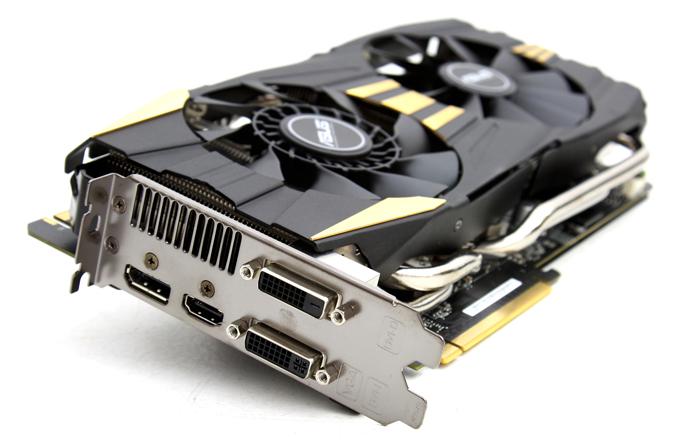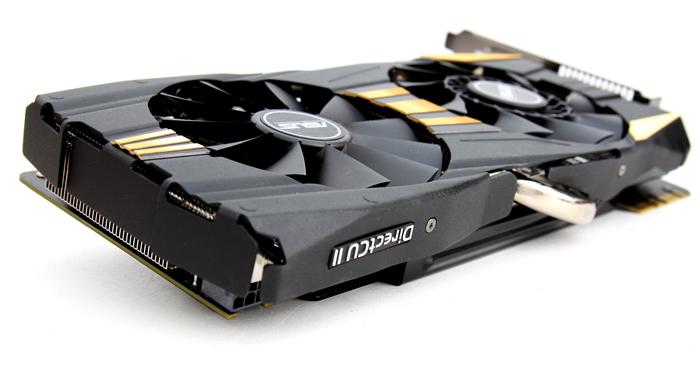Conclusion
Conclusion
Admittedly I like the DirectCU products from ASUS, they almost always offer a nice balance inbetween low noise and cooling levels. That and the cards just look great. The performance that the ASUS GeForce GTX 780 Ti DCUII OC is able to deliver is very good, the DirectCU II cooler that is very silent and keeps this GPU chilled down at a cool roughly a 70 Degrees C temperature. ASUS factory clocked this product at 956 MHz on the baseclock, 1020 Mhz on the boost clock. The end result is a graphics card that can be compared with the GeForce GTX Titan, for less money of course.
Aesthetics
This DirectCU II OC edition graphics card comes with the latest revision of the DirectCU cooler and is roughly 10 degrees Celsius cooler/lower opposed to the reference cooler whist remaining silent. This revision is a dual-slot solution with two distinct fans, which I think just looks great. The PCB is customized and I can only spot quality components ensuring a longer lifespan of this product, lovely. The looks, well the cooler in its all black design, the two subtle and silent fans combined with a hint of red or yellow at your choice, ASUS includes the stickers that you can apply yourself. The card is also very sturdy. There is a metal plate at the top of the card so the card cannot bend when seated horizontally in the PC, also present is a full cover back-plate.
Cooling & Noise Levels
The NVIDIA reference coolers do their job well, but they follow the temperature target of 80 Degrees C. With the DirectCU II cooling technology the GPU will get roughly 400W~450 of cooling power thrown at it. As a result the temperature target might remain at almost 70 Degrees C as reported back by the thermal sensor. I do want to make a side note though, our thermal imaging results (measured at the backside of the PCB at the GPU location) indicate higher GPU temperatures running towards 76 Degrees C. Also the VRM area gets incredibly hot at almost 100 Degrees C. I cannot explain the discrepancy in-between the software monitoring sensor and the thermal imaging results, I however do know that the Thermal imaging results are up-to a few tenth of a degree precise on our calibrated thermal camera.
Power Consumption
The card is rated having a 250 Watt TDP, we measure that to be a little higher though, roughly 260 to 265 Watts (under full stress). But at this performance level, that is absolutely okay. That 250 Watt TDP also will make running multi-GPU solutions a bit easier. With two cards we think an 800 Watt PSU would be sufficient. So while it's not great to have a GPU sucking up 250 Watt it could have been a lot worse, really. If you look at the dual-GPU based ARES II for example, that card alone draws 500 Watt / 250 Watt per GPU. So, perspective is the word I like you to keep in mind.
Game Performance
The GeForce GTX 780 Ti in most scenarios will be 5 to 10% faster than the GTX Titan, comparing towards GTX 680 it seems 40% faster. Drivers wise we can't complain at all, we did not stumble into any issues. And with a single GPU there's no micro-stuttering (if that ever bothered you) and no multi-GPU driver issues to fight off. Performance wise, really there's not one game that won't run seriously good at the very best image quality settings. You should game with a nice 30" monitor of course, at 2560x1440/1600. I mean Battlefield 4 at Ultra quality is still oozing out 65+ FPS there. Or what about Hitman Absolution with 65+ FPS at 2560x1440 High quality and 2xMSAA? At these resolutions the GeForce GTX 780 Ti offers just a phenomenal gaming experience with image quality that you can only see on a PC.
Overclocking
The card is already clocked for you at and boosting to 1020 MHz. This GPU can take 1150 MHz fairly easily really, and at that stage you added another 10% performance already. Our tweak made the GPU boosting at roughly 1200 MHz (depending on temperature, power draw and load). This was the absolute max though as passing that frequency easily would get us into crashing problems. This result is fairly similar on all GTX 780 Ti cards, mind you that we did not voltage tweak. That way this 2880 Shader processor card at a boost frequency of 1200+ MHz this way only consumes 10~15 Watts more, which is pretty nice.
Concluding
ASUS has a lovely graphics card at hand with the ASUS GeForce GTX 780 Ti DCUII OC. It remains fairly silent and has great looks. Cooling we see 70 Degrees C on the thermal probe and 75 Degrees C with thermal imaging. These are okay temperatures. The VRM area is getting hot though, and therein lays a concern as I find 100 Degrees C on the VRM area just too high by any standard. 70 to 80 degrees C is what that should be and I'll even take 90 degrees as 'acceptable'. Now the VRM area can take it, as these temperatures fall with normal operating temperatures, but it's not going to help you with with overclocking though. Overall the ASUS GeForce GTX 780 Ti DCUII OC is a robust build with good components quality, it's darn fast in performance as it even can pass the mighty GeForce GTX Titan at less money. Fluid like gameplay is what you get back in return whilst you enable the most intensive image quality settings. And isn't that what it is all about with PC gaming ? We can recommend the ASUS GeForce GTX 780 Ti DCUII OC but we would not tweak with it too much. The extremely hot VRM area keeps bothering me though, regardless, the card is a serious contender against AMDs R9 line-up.
Recommended Downloads
- Sign up to receive a notice when we publish a new article
- Or go back to Guru3D's front page




